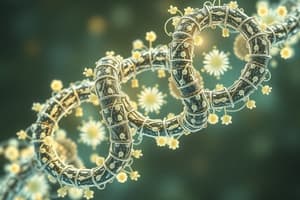Podcast
Questions and Answers
What is the structure of the adenosine triphosphate (ATP) molecule?
What is the structure of the adenosine triphosphate (ATP) molecule?
Adenine, ribose sugar, and three phosphate groups linked by high-energy phosphoanhydride bonds.
Who discovered adenosine triphosphate (ATP) and in what year?
Who discovered adenosine triphosphate (ATP) and in what year?
Karl Lohmann, in 1929.
ATP is known as the 'energy currency' of the cell.
ATP is known as the 'energy currency' of the cell.
True (A)
How can ATP be produced?
How can ATP be produced?
When ATP is consumed, it is converted to _____ or _____
When ATP is consumed, it is converted to _____ or _____
What happens to ATP when a cell needs energy?
What happens to ATP when a cell needs energy?
During the hydrolysis of ATP, what molecules are produced?
During the hydrolysis of ATP, what molecules are produced?
What is the role of water in the hydrolysis of ATP?
What is the role of water in the hydrolysis of ATP?
ATP is formed by adding a phosphate group to ADP when a cell has extra energy.
ATP is formed by adding a phosphate group to ADP when a cell has extra energy.
Flashcards are hidden until you start studying
Study Notes
Adenosine Triphosphate (ATP)
- Discovered by Karl Lohmann in 1929.
- Lohmann isolated ATP from muscle and liver extracts.
- ATP is a nucleoside triphosphate, composed of adenine, ribose sugar, and three phosphate groups.
- The three phosphate groups are linked by two high-energy phosphoanhydride bonds.
- ATP is often referred to as the "energy currency" of the cell, as it stores and releases energy in the bonds between its phosphate groups.
ATP Production
- ATP is produced via cellular respiration, breaking down food for energy.
- ATP can also be produced without oxygen:
- Photosynthesis in plants and algae.
- Anaerobic glycolysis in human cells during strenuous exercise.
ATP Consumption
- ATP is consumed in various cellular processes, including:
- Ion transport.
- Muscle contraction.
- Nerve impulse propagation.
- Substrate phosphorylation.
- Chemical synthesis.
- When consumed, ATP is converted to adenosine diphosphate (ADP) or adenosine monophosphate (AMP).
ATP-ADP Cycle
- The ATP-ADP cycle is a crucial process involving the conversion of ATP to ADP and back again.
- Conversion from ATP to ADP:
- When cells require energy, ATP loses a phosphate group and becomes ADP, releasing energy.
- This process is called hydrolysis.
- Hydrolysis of ATP involves adding water, breaking the bond, and releasing energy.
- The energy released fuels various cellular processes.
- The reaction is represented as: ATP + H2O → ADP + Pi + energy
- Conversion from ADP to ATP:
- When cells have excess energy, ADP is converted back to ATP by adding a phosphate group.
- Cells obtain energy from various sources like food (glucose) or sunlight (in plants).
- This energy is used to add a phosphate group to ADP, transforming it back to ATP.
Studying That Suits You
Use AI to generate personalized quizzes and flashcards to suit your learning preferences.




